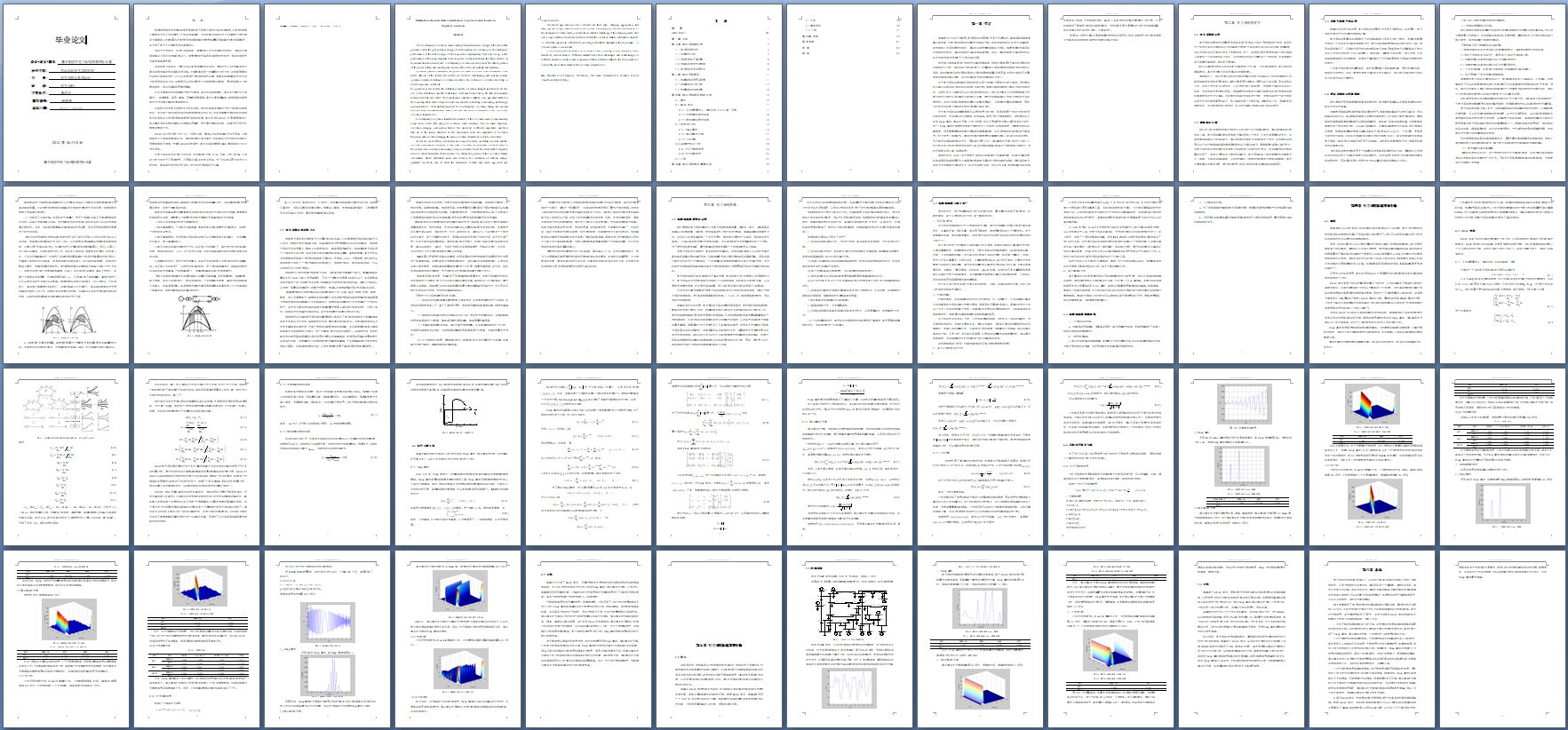基于轨迹的电力系统振荡特征计算

基于轨迹的电力系统振荡特征计算(任务书,开题报告,外文翻译,论文22000字)
摘 要
低频振荡指的是发电机组电网势能与转子动能之间长时间的机电振荡,从电气的角度上看表现为该互补机群定子之间的功率振荡,而在机械上则表现为互补机群转子相对角的长期摆动。近年来国内外电网出现低频振荡的次数愈加频繁,所造成的危害也越来越大,这引起了电力企业和学术界的高度关注。
系统产生扰动后,将发生功率振荡,如果扰动不大且系统稳定性较好,系统将回复到起始运行状态并持续正常运行。如果扰动较大或系统自身稳定性较差,系统将振荡失步或直接单调失稳。
在实际电力系统中,扰动必定以某种强度和形式存在。扰动的大小与扰动本身和平衡点距稳定域边界的距离有所关联。时域仿真法是一种重要的分析方法,在求取需要的时间响应曲线的同时,还可以处理强时变和强非线性因素。如果在低频振荡研究中采用分析受扰轨迹的方法,这样既可以反映扰动大小对振荡特性的影响,同时也能够充分考虑非线性、非自治等实际因素的影响。
许多因素都会对低频振荡过程产生影响,其中包括振荡模式(本文中主要讨论主导模式)、振荡频率、阻尼、幅值、灵敏度系数等等。本文主要选择幅值、振荡频率和振荡阻尼作为所要计算的主要振荡特征。 [版权所有:http://DOC163.com]
在实际生活中电力系统大多为多机系统,每台机组都会有相对于统一参考点的振荡轨迹,并且每一条轨迹中包含的振荡信息也都有所区别。因此选择最为合适的轨迹曲线来反映系统运行状况是提取振荡特征信息的前提。本文中介绍EEAC(扩展等面积法则)来计算各系统的稳定裕度以及参数的灵敏度,便于揭示稳定的机理,并能应用于绝大多数复杂模型之中。
EEAC的应用过程分为3步。分别为分群、聚合以及映射成单机无穷大系统。分群帮助进行主导振荡模式的识别,聚合配合弱化其余模式,射成单机无穷大系统则提取出所需振荡特征信息。为体现EEAC的优越性,本文在实验中根据IEEE准则构造10机39节点系统。
对电力系统轨迹的分析方式多种,包括傅立叶变换、Prony变换、小波分析等。不同的分析方法对于不同的信号、不同情况有各自的优劣所在。为了对这些不同方法进行分析比较,本实验中会分别才用上述3种方法进行振荡特征计算。
关键词: 低频振荡 振荡特征 EEAC 傅立叶变换 小波分析
Oscillation characteristics calculation of power system based on trajectory analysis
Abstract
The low frequency oscillation means lasting between the kinetic energy of the rotor of the generator set to the grid potential energy of electromechanical oscillations in the mechanical performance of the relative angle of the long-term complementary fleet rotor swing, in the performance of the complementary electrical power oscillations between the stator clusters. At home and abroad in recent years, low-frequency oscillation seriously raises the stable operation of the power system, and caused great concern of the electricity industry and academia. [资料来源:https://www.doc163.com]
System to produce disturbance, the power oscillation will occur if the disturbance is not better stability of the system, the system will revert to start running and continue normal operation. Greater disturbance or system less stable, the system will oscillate out-of-step or directly monotonic instability.
In a practical power system, the disturbance must be of certain strength and form exists. The size of the disturbance and the disturbance itself and balance dot pitch stability boundary distance has been associated. The time-domain simulation method is an important method in the time required to strike a response curve can also deal with strong time-varying and strongly nonlinear factors. The disturbed trajectory for low-frequency oscillation, taking into account the non-linear, non-autonomous factors, but can also reflect disturbance of the size of the oscillation characteristics.
Low-frequency oscillation characterizes elements of the oscillation mode (complementary composition of the fleet and grid oscillation center interface), the oscillation frequency, oscillation damping, participation factors, the sensitivity coefficient, amplitude, and their stability in the spatial structure. In this experiment, select the amplitude of oscillation frequency and oscillation damping the main oscillation characteristics as to be calculated. [资料来源:https://www.doc163.com]
In real life, most of the power systems are complex systems, more than one track, and the oscillation information contained in each track is different, the dominant oscillation mode of the system is not necessarily dominant position in all tracks. Select the most suitable trajectory curve to reflect the health of the system is to extract the premise of the oscillation feature information. EEAC (Extended equal area criterion) for calculation of stability margin, parameter sensitivity, easy to reveal the mechanism of stable and can be applied to any complex models.
The EEAC application process is divided into three steps. Grouping, aggregation, and mapping into a single machine infinite bus system. Clustering help with the identification of the dominant oscillation mode, polymerization with the weakening of the remaining mode, shot into a single machine infinite bus system to extract the oscillation feature information required. To reflect the superiority of the EEAC, according to the IEEE standards in the experiment, a 39-node system is constructed. [资料来源:http://Doc163.com]
Power system trajectory analysis in a variety of ways, including Fourier transform, Prony transform, wavelet analysis. Different methods have their advantages and disadvantages in different situations. Analysis and comparison of these different methods, the experiment will only use the above three methods for oscillation characteristics.
Key Words: Low Frequency Oscillations; Oscillation Characteristics; Window Fourier Transform; Wavelet Ridge
[来源:http://Doc163.com]

目 录
摘 要 I
ABSTRACT III
第一章 引言 1
第二章 电力系统稳定性 3
2.1 电力系统稳定性 3
2.2 功角稳定分析 3
2.3 系统失稳的严重后果 4
2.4 提高系统稳定性的措施 4
2.5 电力系统未来发展方向 8
第三章 电力系统振荡 11
3.1 低频振荡的原因及后果 11
3.2 低频振荡的分析方法 13
3.3 低频振荡的抑制对策 14
第四章 电力系统振荡特征分析 16
4.1 概述 16
4.2 EEAC理论 17
4.2.1 互补群惯量中心-相对运动 (CCCOI-RM) 变换 17
4.2.2 失稳映象的稳定裕度 18
4.2.3 稳定映象的稳定裕度 18
4.3 信号分析方法 19
4.3.1 Prony算法 19
4.3.2 窗口傅里叶变换 22
4.3.3 小波变换 23
4.4 具体信号特征分析 24
4.4.1 时不变振荡信号 24
4.4.2 时变振荡信号 30
4.5 小结 32
第五章 电力系统振荡算例分析 34
5.1引言 34
5.2算例系统 34
5.3 小结 37
第六章 总结 39
参考文献 41
附 录 43
致 谢 45 [资料来源:http://doc163.com]
